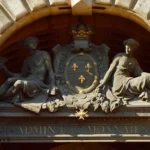Château de Chambord, the undisputed gem of the Loire Valley, is a dream destination for anyone who loves history, architecture, or simply stunning scenery. This majestic castle, with its soaring towers, intricate details, and vast manicured gardens, is like something out of a fairytale. But Chambord is more than just a pretty face; it’s a living testament to the grandeur and ingenuity of the Renaissance period. Prepare to be enchanted as you step back in time and explore the opulent rooms, stroll through the picturesque gardens, and uncover the secrets of this architectural marvel. Whether you’re a history buff, a nature lover, or simply looking for a unique and unforgettable travel experience, Chambord is sure to leave a lasting impression.
Chambord: A Fairytale Castle in the Loire Valley
As you approach Chambord, its sheer size and majestic silhouette rising from the flat landscape will take your breath away. The castle’s white stone façade gleams in the sunlight, and its towers and turrets seem to pierce the sky. It’s no wonder Chambord is considered the crown jewel of the Loire Valley’s many châteaux.
Step inside, and you’ll be transported to a world of royal grandeur. The lavishly decorated rooms are filled with opulent furnishings, intricate tapestries, and priceless works of art. You’ll feel like you’ve stepped back in time to the days of King Francis I, who commissioned the castle in the 16th century.
One of Chambord’s most impressive features is its vast, manicured gardens. Take a leisurely stroll through the perfectly manicured lawns, admire the colorful flowerbeds, and get lost in the maze of hedges. On a warm day, there’s nothing quite like relaxing by the tranquil lake or enjoying a picnic in the shade of a centuries-old tree.
Royal Origins: The Vision of King Francis I
Chambord was the brainchild of King Francis I, a passionate patron of the arts and architecture. He envisioned the castle as a symbol of his power and prestige, a place where he could entertain guests in lavish style.
Construction began in 1519, but Francis I sadly died before Chambord was completed. His son, Henry II, continued the work, but the castle was never fully finished. Despite this, Chambord remains one of the most impressive architectural achievements of the Renaissance period.
Visiting Chambord is like stepping into a living history book. You can explore the rooms where Francis I and his court once lived and entertained, and imagine the grand feasts and lavish celebrations that took place within the castle walls. It’s a truly unforgettable experience.
Architectural Marvel: Renaissance Splendor Meets Medieval Design
Chambord is a unique blend of Renaissance and medieval architecture. The castle’s exterior features classic Renaissance elements like symmetrical proportions, classical columns, and ornate sculptures. But look closer, and you’ll notice medieval touches like soaring towers, crenelated battlements, and a defensive moat.
One of Chambord’s most distinctive features is its elaborate roofline. It’s a veritable forest of chimneys, dormers, and spires, all adorned with intricate carvings and sculptures. The roof is said to be inspired by the skyline of Constantinople, which Francis I had seen on his travels.
Take some time to wander around the castle’s exterior and admire the intricate details of its architecture. You’ll discover hidden courtyards, secret passageways, and stunning views of the surrounding countryside. Chambord is a photographer’s dream, so be sure to bring your camera!
The Double Helix Staircase: A Da Vinci-Inspired Masterpiece?
One of Chambord’s most famous features is its double helix staircase. This ingenious design consists of two spiral staircases that intertwine but never intersect. It’s said that you can climb one staircase and descend the other without ever encountering the person on the opposite staircase.
Legend has it that Leonardo da Vinci designed the staircase, but there’s no concrete evidence to support this claim. Whether or not da Vinci was involved, the double helix staircase is a testament to the ingenuity and creativity of the Renaissance period.
Be sure to take a walk up and down the staircase during your visit to Chambord. It’s a truly unique experience, and you’ll be amazed by the cleverness of its design.
Rooftops of Chambord: Salamanders & Spires
Don’t miss the opportunity to climb to the top of Chambord’s roof terrace. The views from here are simply breathtaking, stretching across the vast estate and surrounding countryside. But the roof terrace is more than just a vantage point; it’s a masterpiece of Renaissance sculpture.
Look out for the hundreds of salamanders that adorn the roof. The salamander was the emblem of Francis I, and it’s said that he chose it because it was believed to be a creature that could withstand fire.
You’ll also find numerous other sculptures on the roof terrace, including statues of mythological figures, gargoyles, and intricate stone carvings. Take your time to explore this open-air museum and admire the artistry of the Renaissance period.
The Chambord Estate: Explore the Gardens & Forests
Chambord isn’t just a castle; it’s a vast estate encompassing over 13,000 acres of gardens, forests, and farmland. There’s so much to explore here, so be sure to allow plenty of time to wander around and soak up the atmosphere.
If you’re a nature lover, you’ll be in heaven at Chambord. The estate is home to a wide variety of flora and fauna, including deer, wild boar, and numerous bird species. You can explore the forests on foot, by bike, or even on horseback.
The gardens are a highlight of any visit to Chambord. They were designed by some of the most renowned landscape architects of the Renaissance period, and they’re a testament to the artistry and ingenuity of the time. Take a leisurely stroll through the perfectly manicured lawns, admire the colorful flowerbeds, and get lost in the maze of hedges.
The French Formal Gardens: A Stroll Through History
The French formal gardens at Chambord are a true masterpiece of Renaissance landscape design. They’re characterized by their geometric layouts, perfectly manicured lawns, and intricate patterns of flowerbeds. The gardens were designed to be a place of beauty and tranquility, a place where the royal court could escape the hustle and bustle of everyday life.
One of the most striking features of the gardens is the Grand Canal. This long, narrow waterway stretches across the estate, reflecting the sky and the surrounding landscape. It’s a popular spot for boating and fishing, and it’s also a great place to simply relax and enjoy the scenery.
Be sure to visit the Orangerie, a large greenhouse where citrus trees were once grown during the winter months. Today, the Orangerie is used for exhibitions and events, but it’s still a fascinating glimpse into the past.
Wildlife Encounters: Spotting Deer in Chambord’s Park
Chambord’s vast park is home to a large population of deer. These graceful creatures can often be seen grazing in the meadows or roaming through the forests. If you’re lucky, you might even spot a fawn or two.
The best time to see the deer is early in the morning or late in the afternoon, when they’re most active. Keep your eyes peeled, and you’re sure to be rewarded with a memorable wildlife encounter.
If you’re a birdwatcher, Chambord is a great place to indulge your passion. The estate is home to a wide variety of bird species, including herons, egrets, and kingfishers. Bring your binoculars and see how many different birds you can spot.
Chambord’s Cultural Calendar: Festivals & Events
Chambord is a lively place throughout the year, with a packed calendar of festivals and events. There’s always something going on, so be sure to check the schedule before your visit.
One of the most popular events is the Chambord Festival, which takes place in July and August. This festival features a variety of classical music concerts, theater performances, and dance recitals. It’s a great way to experience the cultural side of Chambord.
Other events throughout the year include Christmas markets, equestrian shows, and historical reenactments. There’s something for everyone at Chambord, so you’re sure to find an event that interests you.
Taste of Chambord: Local Cuisine & Wine Pairings
No visit to Chambord would be complete without sampling the local cuisine. The Loire Valley is known for its fresh produce, delicious cheeses, and world-renowned wines. There are numerous restaurants and cafes in the vicinity of Chambord, so you’ll be spoilt for choice.
Be sure to try some of the local specialties, such as rillettes (a type of potted meat), tarte tatin (an upside-down apple tart), and coq au vin (chicken braised in red wine). And of course, no meal would be complete without a glass of Loire Valley wine.
If you’re looking for a truly unique dining experience, consider booking a table at one of Chambord’s restaurants. The castle’s restaurants offer stunning views of the estate, and the menus feature seasonal dishes made with fresh, local ingredients.
Planning Your Visit: Tips for Chambord Travelers
Chambord is a popular tourist destination, so it’s best to plan your visit in advance. The castle is open to the public year-round, but the busiest times are during the summer months and on weekends.
If you’re visiting during peak season, it’s a good idea to book your tickets online in advance. This will save you time and hassle, and it will also ensure that you get the tickets you want.
There are a few different ways to get to Chambord. If you’re driving, there’s ample parking available on site. If you’re taking public transportation, there are regular trains and buses from Paris and other major cities.
Loire Valley Beyond Chambord: Day Trip Inspiration
While Chambord is undoubtedly the star attraction of the Loire Valley, there are many other châteaux and interesting places to visit in the region. If you have time, consider taking a day trip to one of the following destinations:
- Château de Chenonceau: This stunning castle is known as the “Ladies’ Château” because it was built and expanded by a series of influential women. It’s famous for its bridge over the Cher River and its beautiful gardens.
- Château de Cheverny: This elegant castle is still inhabited by the same family that built it in the 17th century. It’s known for its lavish interiors and its impressive collection of furniture and art.
- Château d’Amboise: This historic castle was once the residence of King Charles VIII and Leonardo da Vinci. It’s a great place to learn about the history of the Loire Valley and to see some of da Vinci’s inventions.
- The city of Tours: This vibrant city is the capital of the Loire Valley and a great base for exploring the region. It’s home to a number of museums, art galleries, and historic buildings.











